Socorro Aggressor, Revillagigedo Islands, MexicoContents of this Issue: Sorido Bay Dive Resort, Raja Ampat, Indonesia Jellyfish Mucus Found to be a Cause of Sea Itch Is that Aquarium Coral Farmed or Wild Coral? You Can’t Tell Socorro Aggressor, Revillagigedo Islands, Mexico Those Full-face Snorkeling Masks – More to the Story Goliath Groupers: Better in the Water than on the Plate How Much “Fat Shaming” Is There in Diving? Your Reader Reports are the lifeblood of Undercurrent Why You Need Medical Evacuation Insurance Coronavirus – Will it Affect Your Dive Travel Plans? Editorial Office: Ben Davison Publisher and Editor Undercurrent 3020 Bridgeway, Suite 102 Sausalito, CA 94965 will dry-docking make her worth the price? from the March, 2020 issue of Undercurrent
Dear Fellow Diver, I've had a lot of great experiences on Aggressor boats, and I looked forward to diving with the big stuff around Mexico's Revillagigedo Islands. After all, having dived on Belize Aggressors twice, as well as Bahamas, Palau, and Indo Aggressors, I figured I could count on them.
The next morning at 7:45 a.m., I rolled my bags down to the pier, boarded the vessel with a diverse bunch from France, Mexico, Switzerland, Germany, and the U.S., got my stateroom assignment, and was ready to go ... but the ship wasn't. Three hours later, the Aggressor finally began a slow departure, stopping soon to lift and load their three tenders. As they started using the Aggressor crane, a hydraulic line blew. My reaction was "oh my ... here we go again." It took awhile to repair the crane and get the tenders loaded. Just before 2 p.m., we started our 24-hour journey. The Socorro Aggressor joined the Aggressor family in early 2019, after serving in the Red Sea as the MV Cassiopeia. Built in 2006, it had a major restoration in 2012. Once a 5-star luxury yacht, today it's worn and tired, with signs of rust everywhere: the wooden decking on the bottom dive platform was gone, leaving only rusted painted steel; duct tape held power cords together and secured connectors on the high-pressure hoses used to fill the tanks, and carpet runners covered the worn carpet in the below-deck hallway. After a 26-hour transit, we arrived about 3:30 p.m. with only enough time for one dive. Our guide ended the dive after 25 minutes, and I didn't see much, whereas the other two groups were down 40 minutes and saw sharks. But after that dive, I have but one word for the remainder of the diving. Great! The volcanic Revillagigedo Islands, which include Socorro and San Benedicto, underwater sport a predominately rock and boulder topography. At sites like El Boiler and Roca Partida, the rock rises straight from the seafloor, making for interesting circumnavigation around the entire mountains of rock, where large schools of trevally roamed. Most diving was 60-90 feet, more often near 60 feet. There were little coral and few small fish, and I saw lobsters, a skittish octopus, and a very large tuna. But this was a trip all about the sharks, mantas, and dolphins -- even a surprise visit by a whale shark. Our first full diving day, we moved to a nearby bay and the El Canyon dive site. Here, we twice dropped in, needing just a short kick to reach a cleaning station that was visited constantly by white tip, silver tip and Galapagos sharks, as well as giant mantas. They kept circling, so I could easily shoot from different angles. On two spectacular dives, giant Pacific mantas came in very close. A couple of dives we began out in the blue, hoping to see hammerheads on our swim to the cleaning station. I didn't, but divers in the other groups spotted them. My highlight? On this day, it was seeing a black giant manta swimming in our bubbles; another day watching a dolphin clean another dolphin ... this was the most action-packed dive site of our cruise.
The yacht has a lot of smoke detectors, but none was near the charging stations; when mentioned to the crew, a few minutes later they installed one. Later, when we were in the dining room, it went off (someone was burning toast), but it was not loud enough to be heard throughout the boat. They do not appear to be interconnected into a central alarm system. So, with engines running and some people sleeping with earplugs, a single alarm from a smoke detector may not be heard by all. Someone would have to alert everyone on board to a fire. My air-conditioned stateroom was adequate -- the mattress was a bit hard -- but the bathroom reeked of sewer gas; other divers also had the foul odors in their bathrooms. Wisely, the crew allowed no battery charging in the staterooms and unplugged any they found. The charging station inside the dive deck doorway had mostly 220v outlets and a 110v power strip with about a dozen outlets. It was a bit of a mess, with charging laptops, iPads, lights, camera batteries, and dive computers. With one large camera table on the dive deck and two smaller tables in a corner, it got a little tight for us photographers. I rinsed my camera with the shower hose, so I didn't have to put my heavy rig on top of someone else's camera in the rinse tank. Each day started in the dining room -- it has bench seats and rigid tables -- with a continental breakfast around 6 a.m.: breads, fruit, yogurt, and coffee. Full breakfast came after the first dive, usually eggs or omelets and breakfast meats. Lunches and dinners had a Mexican twist but were otherwise unmemorable: soups and entrees of fish, chicken, pork, and beef, all rather bland. As a fellow diver said to me, "somewhere between hospital and school cafeteria food." Some of the food was at best lukewarm, or even cold. Our New Year's Eve was uneventful, unlike Christmas on the Belize Aggressor a few years back with decorations, a full turkey, and so on. Additionally, they ran out of their best beer and even ran out of Coke! While wine was complimentary, the white was poor, the red passable. Between-dive snacks were cookies or pastries, much of it still in a Costco container.
All the dives were guided -- buddies were required -- but the guide let some group together, as long as they stayed within his sight. Rana, who guided half my dives, was awesome underwater, showing a hilarious expression of enthusiasm whenever we came across mantas ... and more seemed to show up when Rana led our dives. Daren, from the U.K., guided the other dives. He seemed to be in his own world at times, sometimes rarely looking back at us. Two other guides, Trucu, a local, and Nico (France), were great guides, always having fun. They never conducted a formal roll call after a dive, but each tender captain clearly knew if he had his charges. Occasionally, a diver or two would surface early and be picked up by a different tender, coordinated by the captains constantly talking with each other by radio. The third dive day, we moved to another part of San Benedicto to dive "El Boiler," a submerged rock formation that bottoms out at 120 feet. After four dives here, I had covered the entire formation, while encountering a spattering of smaller white tip sharks, jacks, giant trevally, and some snapper; even a pod of dolphin passed through during one dive. The real heart-pounding was when Pacific mantas appeared. They are beautiful creatures, especially the black mantas. While filming one, I spotted a whale shark. I tried to follow, but it had gone too far; however, when I returned to the rock formation, it was coming back, and I was directly in its path. As I'm filming, a manta came winging over my shoulder. "Oh My! What do I film?" It was a great dilemma to have -- two amazing subjects to film -- I got both!
The fifth dive day at Socorro Island, we made four dives at "Cabo Pierce" dive site -- basically a long finger of rock with sheer walls on both sides. Two dives were totally WOW experiences. A couple of giant Pacific mantas came around; one being of the totally black 'ninja' coloration put on quite an up-close show. If you stay still, they will come right at you through the bubbles. Our sixth dive day was back at San Benedicto island and the "El Canyon" dive site. This day was probably the most complete bucket-list day of all my 31 years of diving. We had many sharks and mantas, lots of dolphins, and the visibility was excellent! I got two "firsts" -- I filmed a dolphin cleaning a dolphin, and I got eye-to-eye with a school of hammerheads -- it was just a spectacular day of diving, and a great way to end the cruise! It seemed a trip too short, though ending similarly to how it began -- with issues. Arriving at Cabo late in the evening, we anchored in the bay. The next morning, our bags packed, we learned the captain could not bring the yacht into port -- there was no room for us. Eventually, we 20-plus divers and our luggage made our way via RIBs to the pier (about 2,000 yards), with the waves giving some of us a good dousing (a good thing it wasn't raining).
Here's what their email states they plan to do: "The yacht has two weeks of scheduled maintenance that are occurring now. During this time, the replacement of carpets (which was started, but not completed on your cruise) will be completed. Wallpapers will be torn down and replaced. A number of the stateroom bathrooms will also be refurbished . . . While total refurbishment is scheduled later this year, there is no excuse for the issues many of you described in the guest surveys we received. we have been working with the owners, management, and staff of the Socorro Aggressor on known areas of deficiencies for a while. It was obvious too little was happening too slowly. Since your cruise, we have put the yacht on our fast track program to ensure immediate compliance in every area. The program tightens the compliance from a verbal acknowledgment to a visual and written detail. As in the past with other owners/destinations, once on the fast track, either immediate compliance is achieved or a move to a new yacht/owner is the only outcome." -- C.J. Our undercover diver's bio: CJ became a recreational diver while stationed in Okinawa, Japan, in 1988. Now retired, he has ramped up his diving, taking 4 to 6 trips per year, traveling as much as his non-diving wife will let him (not often enough!). For the past 5 years, he has been making YouTube videos of his adventures, and has nicknamed his rather large camera setup "The Beast."
|

I want to get all the stories! Tell me how I can become an Undercurrent Online Member and get online access to all the articles of Undercurrent as well as thousands of first hand reports on dive operations world-wide
| Home | Online Members Area | My Account |
Login
|
Join
|
| Travel Index |
Dive Resort & Liveaboard Reviews
|
Featured Reports
|
Recent
Issues
|
Back Issues
|
|
Dive Gear
Index
|
Health/Safety Index
|
Environment & Misc.
Index
|
Seasonal Planner
|
Blogs
|
Free Articles
|
Book Picks
|
News
|
|
Special Offers
|
RSS
|
FAQ
|
About Us
|
Contact Us
|
Links
|
3020 Bridgeway, Ste 102, Sausalito, Ca 94965
All rights reserved.

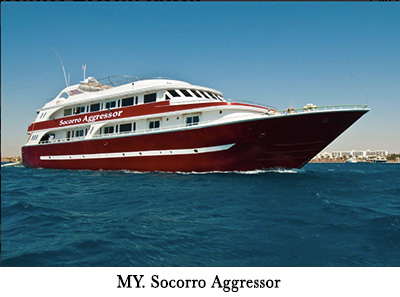 Actually, this was my second attempt to travel with Socorro Aggressor. After boarding the boat last May, the ship had engine problems, and the next day the cruise was canceled. We all received refunds and vouchers for another trip. I rebooked, and the day after Christmas, my son and I headed off to the airport, but after an unscheduled stop in Oklahoma City due to bad weather and a 6-hour wait, we had no chance to make our connection. I called American; the only flight that would get us to Cabo San Lucas in time to board the Aggressor the next morning had but one seat remaining. Begrudgingly, I took it, and my son, an awfully good sport, returned home.
Actually, this was my second attempt to travel with Socorro Aggressor. After boarding the boat last May, the ship had engine problems, and the next day the cruise was canceled. We all received refunds and vouchers for another trip. I rebooked, and the day after Christmas, my son and I headed off to the airport, but after an unscheduled stop in Oklahoma City due to bad weather and a 6-hour wait, we had no chance to make our connection. I called American; the only flight that would get us to Cabo San Lucas in time to board the Aggressor the next morning had but one seat remaining. Begrudgingly, I took it, and my son, an awfully good sport, returned home.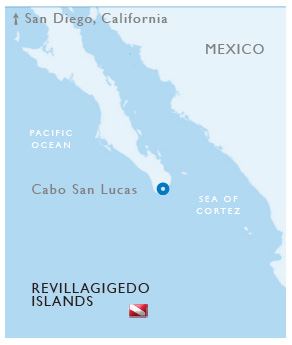 The Conception liveaboard fire, killing 34, has led us divers to think more about safety. Before departing, I wrote the Aggressor fleet about safety concerns, and CEO Wayne Brown responded, saying, "The stateroom orientations always include the emergency exit plans, and we will take any guests that requests it through an actual emergency egress orientation." When I boarded, I was not briefed on the egress plan, so I asked Rana, the cruise director, about it. A mature, experienced, and friendly guy from La Paz, he walked me from my cabin to the ladder to the secondary exit, an opening with no hatch.
The Conception liveaboard fire, killing 34, has led us divers to think more about safety. Before departing, I wrote the Aggressor fleet about safety concerns, and CEO Wayne Brown responded, saying, "The stateroom orientations always include the emergency exit plans, and we will take any guests that requests it through an actual emergency egress orientation." When I boarded, I was not briefed on the egress plan, so I asked Rana, the cruise director, about it. A mature, experienced, and friendly guy from La Paz, he walked me from my cabin to the ladder to the secondary exit, an opening with no hatch.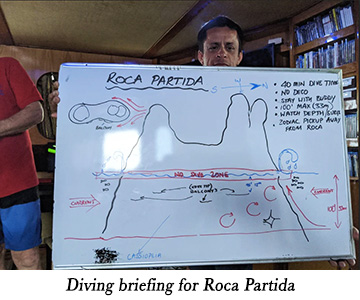 They operate three inflatable dive tenders; boarding them from the lower deck
can be challenging with wave action, so one needs to be careful. I back rolled in,
then after the dive, I removed my BCD and fins before climbing the ladder with the
help of an attentive crew member.
They operate three inflatable dive tenders; boarding them from the lower deck
can be challenging with wave action, so one needs to be careful. I back rolled in,
then after the dive, I removed my BCD and fins before climbing the ladder with the
help of an attentive crew member.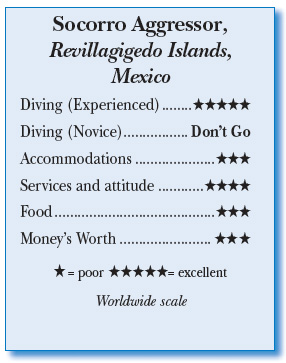 The fourth dive day, we went to an exposed rock outcropping, "Rocka Partida." We only made three dives here because the Aggressor was the last ship to arrive that day. There were lots of white-tips swimming by the dozens near large schools of jacks and triggerfish. I approached a couple of ledges around 80 feet down where perhaps a dozen juvenile whitetips were resting, stacked on top of each other. A puffer fish hovered over the pile of sharks, making for good photos. It was exciting to be swimming through huge schools of fish in excellent visibility, seeing below dozens of sharks skirting in and out. Our guide, Darren, noted that during the dive the U.K. would be crossing into New Years, so about midnight their time (4 p.m. local), he and several divers did their best rendition of a boogie dance.
The fourth dive day, we went to an exposed rock outcropping, "Rocka Partida." We only made three dives here because the Aggressor was the last ship to arrive that day. There were lots of white-tips swimming by the dozens near large schools of jacks and triggerfish. I approached a couple of ledges around 80 feet down where perhaps a dozen juvenile whitetips were resting, stacked on top of each other. A puffer fish hovered over the pile of sharks, making for good photos. It was exciting to be swimming through huge schools of fish in excellent visibility, seeing below dozens of sharks skirting in and out. Our guide, Darren, noted that during the dive the U.K. would be crossing into New Years, so about midnight their time (4 p.m. local), he and several divers did their best rendition of a boogie dance.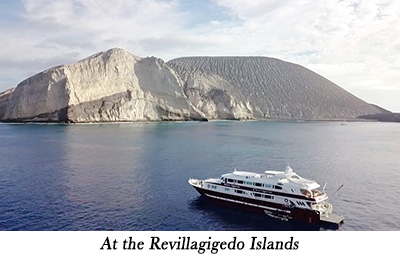 So regardless of the exciting big-fish diving, the Socorro Aggressor just wasn't up to snuff as a quality liveaboard. I provided my unvarnished feedback via email to management, as did many of my companions, and completed the online review they sent after the cruise. Several weeks later, I received a voucher for $500 for any Aggressor cruise and a statement acknowledging that there were known deficiencies and that "too little was happening too slowly." They further stated that they are fast-tracking refurbishment. That said, I would be cautious about booking a trip on this cruise in the near future, but hopefully, they are successful in getting it up to the expected Aggressor standards.
So regardless of the exciting big-fish diving, the Socorro Aggressor just wasn't up to snuff as a quality liveaboard. I provided my unvarnished feedback via email to management, as did many of my companions, and completed the online review they sent after the cruise. Several weeks later, I received a voucher for $500 for any Aggressor cruise and a statement acknowledging that there were known deficiencies and that "too little was happening too slowly." They further stated that they are fast-tracking refurbishment. That said, I would be cautious about booking a trip on this cruise in the near future, but hopefully, they are successful in getting it up to the expected Aggressor standards. Divers Compass: Eight-night trips start at $3495 double occupancy . . . Mexican customs collects a tax on camera gear. Be ready for it (the Aggressor people ought to include this in their "know before you go" information . . . My analyzer reported 31 percent nitrox in the aluminum 80s at the beginning of the week, by end of the week 27 percent, which is too close to air . . . They rent wetsuits, BCDs, regs, mask, fins and 100-cu. ft. steel tanks . . . La Marina Inn, a two-minute walk from the boat, offers a good room, a good restaurant, friendly staff, and a good value.
Divers Compass: Eight-night trips start at $3495 double occupancy . . . Mexican customs collects a tax on camera gear. Be ready for it (the Aggressor people ought to include this in their "know before you go" information . . . My analyzer reported 31 percent nitrox in the aluminum 80s at the beginning of the week, by end of the week 27 percent, which is too close to air . . . They rent wetsuits, BCDs, regs, mask, fins and 100-cu. ft. steel tanks . . . La Marina Inn, a two-minute walk from the boat, offers a good room, a good restaurant, friendly staff, and a good value. 